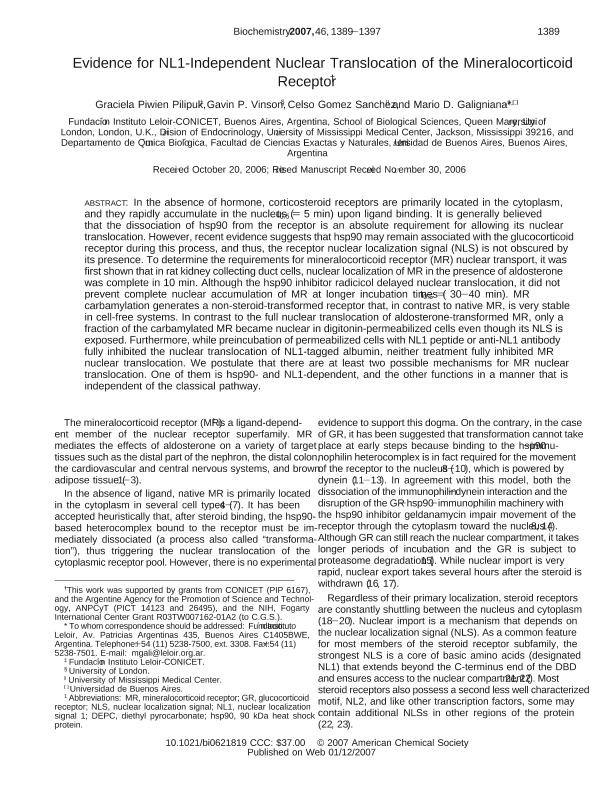Mostrar el registro sencillo del ítem
dc.contributor.author
Piwien Pilipuk, Graciela

dc.contributor.author
Vinson, Gavin P.
dc.contributor.author
Gomez Sanchez, Celso
dc.contributor.author
Galigniana, Mario Daniel

dc.date.available
2017-11-08T14:58:54Z
dc.date.issued
2007
dc.identifier.citation
Piwien Pilipuk, Graciela; Vinson, Gavin P.; Gomez Sanchez, Celso; Galigniana, Mario Daniel; Evidence for NL1-independent nuclear translocation of the mineralocorticoid receptor; American Chemical Society; Biochemistry; 46; 5; -1-2007; 1389-1397
dc.identifier.issn
0006-2960
dc.identifier.uri
http://hdl.handle.net/11336/27824
dc.description.abstract
In the absence of hormone, corticosteroid receptors are primarily located in the cytoplasm, and they rapidly accumulate in the nucleus (t0.5 = 5 min) upon ligand binding. It is generally believed that the dissociation of hsp90 from the receptor is an absolute requirement for allowing its nuclear translocation. However, recent evidence suggests that hsp90 may remain associated with the glucocorticoid receptor during this process, and thus, the receptor nuclear localization signal (NLS) is not obscured by its presence. To determine the requirements for mineralocorticoid receptor (MR) nuclear transport, it was first shown that in rat kidney collecting duct cells, nuclear localization of MR in the presence of aldosterone was complete in 10 min. Although the hsp90 inhibitor radicicol delayed nuclear translocation, it did not prevent complete nuclear accumulation of MR at longer incubation times (t0.5 = 30-40 min). MR carbamylation generates a non-steroid-transformed receptor that, in contrast to native MR, is very stable in cell-free systems. In contrast to the full nuclear translocation of aldosterone-transformed MR, only a fraction of the carbamylated MR became nuclear in digitonin-permeabilized cells even though its NLS is exposed. Furthermore, while preincubation of permeabilized cells with NL1 peptide or anti-NL1 antibody fully inhibited the nuclear translocation of NL1-tagged albumin, neither treatment fully inhibited MR nuclear translocation. We postulate that there are at least two possible mechanisms for MR nuclear translocation. One of them is hsp90- and NL1-dependent, and the other functions in a manner that is independent of the classical pathway.
dc.format
application/pdf
dc.language.iso
eng
dc.publisher
American Chemical Society

dc.rights
info:eu-repo/semantics/openAccess
dc.rights.uri
https://creativecommons.org/licenses/by-nc-sa/2.5/ar/
dc.subject
Aldosterone
dc.subject
Cell Nucleus
dc.subject
Nuclear Localization Signals
dc.subject
Mineralocorticoid Receptors
dc.subject.classification
Bioquímica y Biología Molecular

dc.subject.classification
Medicina Básica

dc.subject.classification
CIENCIAS MÉDICAS Y DE LA SALUD

dc.title
Evidence for NL1-independent nuclear translocation of the mineralocorticoid receptor
dc.type
info:eu-repo/semantics/article
dc.type
info:ar-repo/semantics/artículo
dc.type
info:eu-repo/semantics/publishedVersion
dc.date.updated
2017-10-12T19:49:18Z
dc.identifier.eissn
1520-4995
dc.journal.volume
46
dc.journal.number
5
dc.journal.pagination
1389-1397
dc.journal.pais
Estados Unidos

dc.journal.ciudad
Washington
dc.description.fil
Fil: Piwien Pilipuk, Graciela. Fundación Instituto Leloir; Argentina
dc.description.fil
Fil: Vinson, Gavin P.. University Of London; Reino Unido
dc.description.fil
Fil: Gomez Sanchez, Celso. University Of Mississippi; Estados Unidos
dc.description.fil
Fil: Galigniana, Mario Daniel. Universidad de Buenos Aires. Facultad de Ciencias Exactas y Naturales. Departamento de Química Biológica; Argentina. Fundación Instituto Leloir; Argentina
dc.journal.title
Biochemistry

dc.relation.alternativeid
info:eu-repo/semantics/altIdentifier/url/http://pubs.acs.org/doi/abs/10.1021/bi0621819
dc.relation.alternativeid
info:eu-repo/semantics/altIdentifier/doi/http://dx.doi.org/10.1021/bi0621819
dc.relation.alternativeid
info:eu-repo/semantics/altIdentifier/pmid/17260968
Archivos asociados
